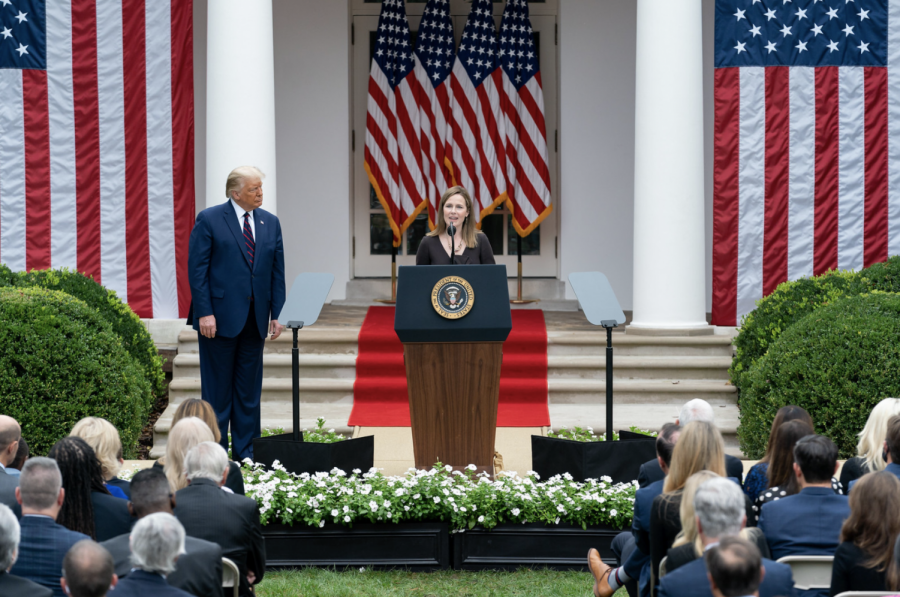Senate Judiciary Committee votes to move Judge Amy Coney Barrett’s nomination forward
With Republican Senate majority, Supreme Court nominee Barrett likely to be confirmed
Andrea Hanks | whitehouse.gov
Judge Amy Coney Barrett gives a speech after President Trump announces her as Supreme Court nominee on Sept. 26. The Senate is expected to confirm her nomination on Monday due to its Republican majority.
October 23, 2020
With the vote of 12 yeas and 10 abstentions in the Senate Judiciary Committee on Oct. 22 moving the nomination of Judge Amy Coney Barrett forward, the Senate plans to vote on her confirmation on Monday. With the current Republican majority in the Senate, Barrett will likely be confirmed.
Democrats boycotted the vote to advance the nomination, forcing the republicans to bypass the rule that required at least two members of the minority party to be present in order to constitute a quorum and allow the committee to vote.
President Donald Trump nominated Barrett on Sept. 26, eight days after Justice Ruth Bader Ginsburg’s passing and 38 days before the upcoming election, making this is the closest a Supreme Court confirmation battle has been to a presidential election in American history. If confirmed, her nomination would be the first presidential pick confirmed in a presidential election year since 1988.
“Since [the Warren Court], even though the Court has been conservative, it’s always really been split five to four, with some moderates in the middle,” said Timothy Johnson, a professor of political science and law at the University of Minnesota. “And if Judge Amy Coney Barrett is confirmed to the bench, this will be the first time in a very long time that we will have six pretty conservative justices and only three liberal justices.”
Whereas Ginsburg fought against discrimination and for women’s rights through her decisions on many cases, Barrett has a history of having conservative views on subjects such as gun rights, immigration, employment discrimination and abortion. Some specific topics on which they differ include abortion, gun rights, and the Affordable Care Act: Ginsburg believed that the Constitution protects a woman’s right to abortion, opposed the broader interpretation of the “right to bear arms” and voted for upholding the law, while Barrett is likely to uphold state restrictions on abortions, interprets gun rights more broadly and has been critical of the Affordable Care Act in the past. Her confirmation would shift the balance of the court further to the right, from 5-4 to 6-3 in favor of conservatives. The potential conservative majority as well as Barrett’s views have raised concerns regarding abortion and LGBTQ+ rights.
“If discrimination protections get overturned, then I or any other LGBT person could be denied employment or housing or healthcare just for being LGBT, and if she plays a part in repealing Obergefell v. Hodges, then it’s equally possible that I may not be able to marry who I fall in love with,” Ally Tiritoglu (12) said.
Although historically there have been unbalanced courts before, if Barrett is confirmed, this will be the most conservative court in recent history. With Barrett and Justices Gorsuch and Kavanaugh all being near or in their fifties, the court could stay unbalanced for years to come.
When Barrett, a member of a Catholic group called People of Praise, was initially nominated to the United States Court of Appeals for the Seventh Circuit, she was questioned on the influence of her religion on her decisions. While religious beliefs themselves are not an issue — the court currently has five Catholics, an Episcopalian, and two Jews — concerns arose over the extremely conservative views of her religious group in particular. The fear was that the influence the church extended over Judge Barrett would impede her from making her own decisions, separate from the church.
Having been mentored by the late Justice Antonin Scalia, Barrett said on Sept. 26 after being nominated, “[Justice Scalia’s] judicial philosophy is mine, too — a judge must apply the law as written.” Justice Scalia had conservative views but his methods sometimes led him to vote the other way. Barrett’s past cases suggest that she is less likely to deviate from the conservative decision than Justice Scalia was. Regarding abortion, her past cases include disagreeing on nullifying a law that tightened the requirements for notifying the parents of minors seeking abortions, and being in agreement with two Indiana laws banning abortions on the basis of the sex or disability of of a fetus and requiring that fetal remains be buried or cremated by the abortion providers.
Some have expressed concerns about the conservative majority having the potential to overturn Roe v. Wade, a major Supreme Court decision that concluded that a pregnant woman’s choice on whether or not to have an abortion is protected under the privacy portion of the Fourteenth Amendment. Although Roe v. Wade has not yet been overturned, the rights expressed in the case could be slowly limited through other decisions rather than overturned outright.
“[The Court doesn’t] necessarily have to overrule Roe v. Wade to bring it out to the same fact,” Dr. Tonja Jacobi, a professor of law at the Northwestern Pritzker School of Law, said.
Based on Barrett’s history, it is possible that the case could be overturned. Precedent is not an issue here, as Barrett wrote in a 2013 law review article that precedent is “not a hard-and-fast rule in the Court’s constitutional cases.
On average, since 1975 it has taken an average of 68 days for a Justice to be confirmed, but the Constitution does not dictate a specific procedure beyond giving power to the president to make nominations and the power to “advice and consent” to the Senate, so the confirmation process can vary widely.
Essentially, once the nomination is turned over to the Senate, members of the Judiciary Committee or senators who would like to meet with the nominee hold informal meetings, and then the Judiciary Committee holds a hearing. However, the vote by the Judiciary Committee at the conclusion of the hearing is merely advisory: every Supreme Court nomination in history has gone on to the Senate, regardless of the judiciary vote. After this vote, the Senate debates for an unlimited amount of time, with a simple majority — at least 51 votes — to end the debate and move onto the final vote for the nomination.
Recent developments with several Republicans testing positive for COVID-19 may have potentially complicated the sped-up timeline that the administration is shooting for. While Senators are allowed to participate in and attend the hearings remotely, there are no provisions for remote voting. Senators must attend in person to vote. Some Senators, including Sen. Chuck Grassley, have chosen not to be tested.
Johnson believes that Barrett’s nomination could potentially have benefits for both parties.
“Politically, the President believes that this will be good for him because it will really coalesce the base on the right,” Johnson said. “The Democrats believe that a quick nomination will actually help them because they believe it will coalesce voters on the left to vote for Vice President Biden.”


















![“[Building nerf blasters] became this outlet of creativity for me that hasn't been matched by anything else. The process [of] making a build complete to your desire is such a painstakingly difficult process, but I've had to learn from [the skills needed from] soldering to proper painting. There's so many different options for everything, if you think about it, it exists. The best part is [that] if it doesn't exist, you can build it yourself," Ishaan Parate said.](https://harkeraquila.com/wp-content/uploads/2022/08/DSC_8149-900x604.jpg)




![“When I came into high school, I was ready to be a follower. But DECA was a game changer for me. It helped me overcome my fear of public speaking, and it's played such a major role in who I've become today. To be able to successfully lead a chapter of 150 students, an officer team and be one of the upperclassmen I once really admired is something I'm [really] proud of,” Anvitha Tummala ('21) said.](https://harkeraquila.com/wp-content/uploads/2021/07/Screen-Shot-2021-07-25-at-9.50.05-AM-900x594.png)







![“I think getting up in the morning and having a sense of purpose [is exciting]. I think without a certain amount of drive, life is kind of obsolete and mundane, and I think having that every single day is what makes each day unique and kind of makes life exciting,” Neymika Jain (12) said.](https://harkeraquila.com/wp-content/uploads/2017/06/Screen-Shot-2017-06-03-at-4.54.16-PM.png)








![“My slogan is ‘slow feet, don’t eat, and I’m hungry.’ You need to run fast to get where you are–you aren't going to get those championships if you aren't fast,” Angel Cervantes (12) said. “I want to do well in school on my tests and in track and win championships for my team. I live by that, [and] I can do that anywhere: in the classroom or on the field.”](https://harkeraquila.com/wp-content/uploads/2018/06/DSC5146-900x601.jpg)
![“[Volleyball has] taught me how to fall correctly, and another thing it taught is that you don’t have to be the best at something to be good at it. If you just hit the ball in a smart way, then it still scores points and you’re good at it. You could be a background player and still make a much bigger impact on the team than you would think,” Anya Gert (’20) said.](https://harkeraquila.com/wp-content/uploads/2020/06/AnnaGert_JinTuan_HoHPhotoEdited-600x900.jpeg)

![“I'm not nearly there yet, but [my confidence has] definitely been getting better since I was pretty shy and timid coming into Harker my freshman year. I know that there's a lot of people that are really confident in what they do, and I really admire them. Everyone's so driven and that has really pushed me to kind of try to find my own place in high school and be more confident,” Alyssa Huang (’20) said.](https://harkeraquila.com/wp-content/uploads/2020/06/AlyssaHuang_EmilyChen_HoHPhoto-900x749.jpeg)











